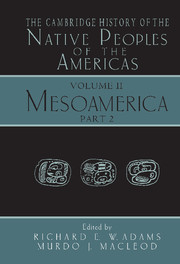Book contents
- Frontmatter
- 12 Mesoamerica Since the Spanish Invasion: an Overview
- 13 Legacies of Resistance, Adaptation, and Tenacity: History of the Native Peoples of Northwest Mexico
- 14 The Native Peoples of Northeastern Mexico
- 15 The Indigenous Peoples of Western Mexico from the Spanish Invasion to the Present
- 16 Native Peoples of Colonial Central Mexico
- 17 Native Peoples of Central Mexico Since Independence
- 18 Native Peoples of the Gulf Coast from the Colonial Period to The Present
- 19 The Indigenous Population of Oaxaca from the Sixteenth Century to the Present
- 20 The Lowland Mayas, from the Conquest to the Present
- 21 The Highland Maya
- Index to Part 2
- Map 12.1: A general map of Mesoamerica, showing major ancient, colonial, and modern population centers"
16 - Native Peoples of Colonial Central Mexico
Published online by Cambridge University Press: 28 March 2008
- Frontmatter
- 12 Mesoamerica Since the Spanish Invasion: an Overview
- 13 Legacies of Resistance, Adaptation, and Tenacity: History of the Native Peoples of Northwest Mexico
- 14 The Native Peoples of Northeastern Mexico
- 15 The Indigenous Peoples of Western Mexico from the Spanish Invasion to the Present
- 16 Native Peoples of Colonial Central Mexico
- 17 Native Peoples of Central Mexico Since Independence
- 18 Native Peoples of the Gulf Coast from the Colonial Period to The Present
- 19 The Indigenous Population of Oaxaca from the Sixteenth Century to the Present
- 20 The Lowland Mayas, from the Conquest to the Present
- 21 The Highland Maya
- Index to Part 2
- Map 12.1: A general map of Mesoamerica, showing major ancient, colonial, and modern population centers"
Summary
Central Mexico is where the greatest number of both Indians and Spaniards lived during the colonial period, so the region has special importance. This central region of Mexico is a fertile area on a large plateau, bounded by mountains and containing a number of valleys. Rainfall and adequate groundwater coupled with productive soil allowed the development of labor-intensive sedentary agriculture and a dense population. The geographical and cultural boundaries closely coincide. The Valley, or Basin, of Mexico, ringed by mountains, had a large lake system that functioned as an inland sea in the prehispanic and colonial periods. On an island in the center of the lake the city of Tenochtitlan was built. In the central basin, Nahuas and Otomís were the primary linguistic/ethnic groups. The Toluca Valley to the west includes Nahuas and Mazahuas; the Cuernavaca region to the south and the Puebla region to the east were rich agriculturally and densely populated with Nahuas. The northern bounds of the geographical and cultural region were relatively near to the center. To the north is desert where nomadic and seminomadic people lived. They shared some cultural traits with the more settled southern populations, but are distinct from the groups under consideration here (Map 16.1).
Keywords
- Type
- Chapter
- Information
- The Cambridge History of the Native Peoples of the Americas , pp. 187 - 222Publisher: Cambridge University PressPrint publication year: 2000
- 14
- Cited by



